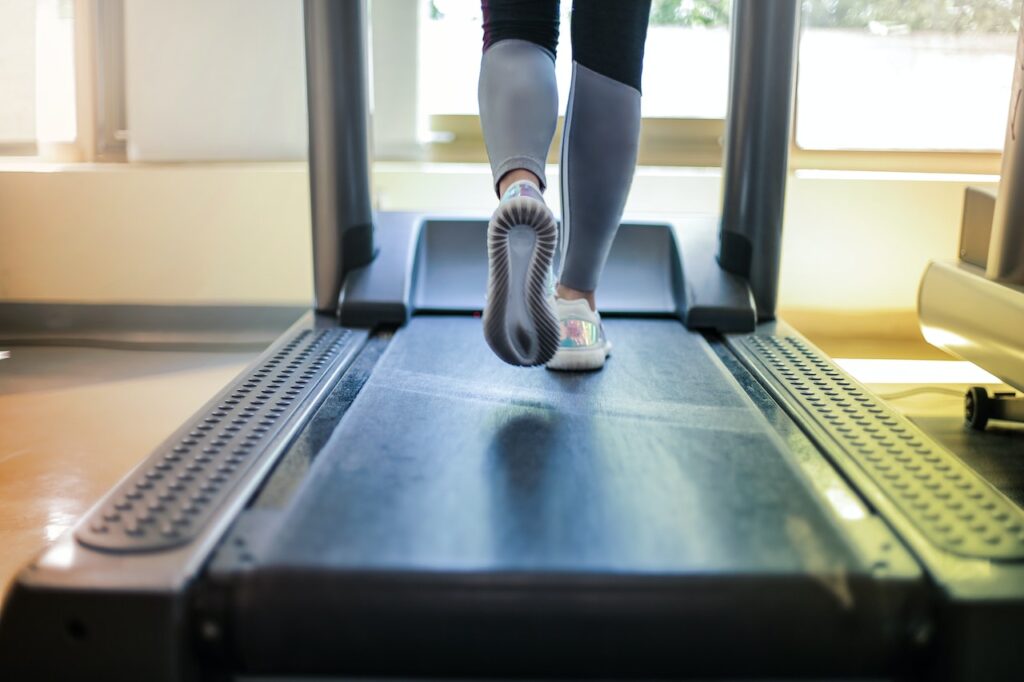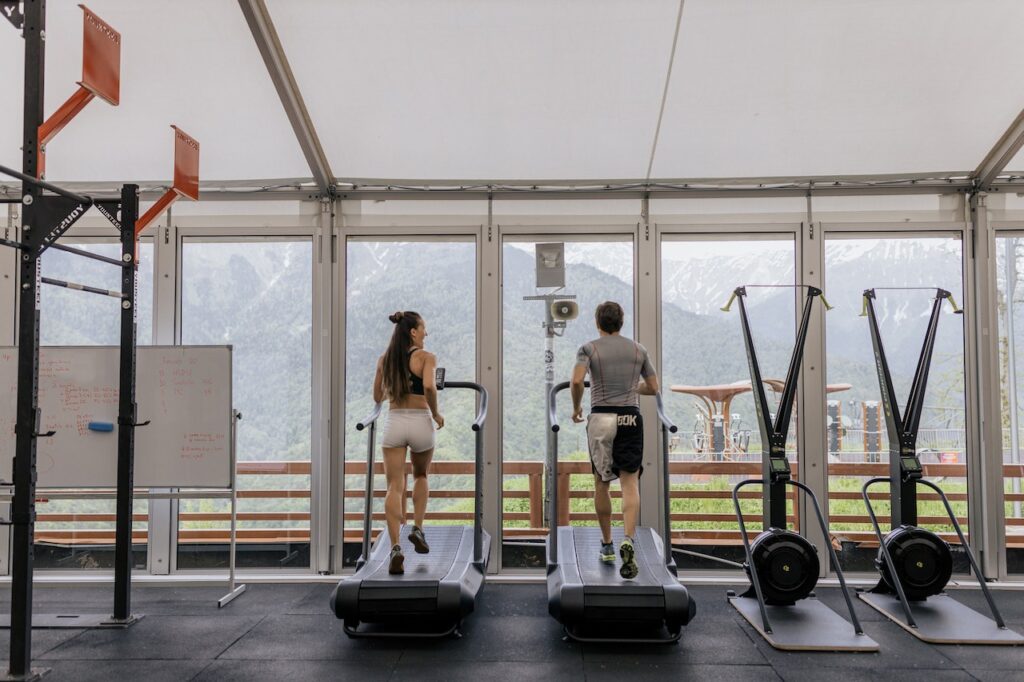Exercises that are designed to increase speed are usually performed on a track or gym. However, bad weather or lack of time may prevent you from going outside to train. The good thing is that you can use your home treadmill for speed training. So how to speed train on a treadmill?
The best way to speed train on a treadmill is by doing treadmill sprints and interval workouts. Interval workouts can enhance your running efficiency, increase endurance and build fast-twitch muscle fibres. Treadmill sprints, on the other hand, can make your legs stronger which will enable you to run faster without much effort.
Continue reading to learn everything you need to know about speed training on a treadmill.

How Speed is Measured on a Treadmill
A treadmill measures speed with either kilometres per hour (kph) or miles per hour (mph). The mph measurement is largely used in the United States but kph is mostly used in many countries such as Australia and Canada in measuring treadmill speed. Some treadmills can show both measurements but they usually default to which country you bought the treadmill.
The treadmill’s speed range also differs by model or brand. See the comparison table and reviews we did with the top treadmills across brands in Australia.
Cheaper treadmills can only raise at 12.9 kph or 16.1 kph while the more expensive ones can top out at 19.3 kph. Make sure you are aware of the treadmill’s speed range before buying one to guarantee that it will suit your fitness goals.
How to Build a Treadmill Sprint Workout
There are some things to keep in mind before you do a sprint workout. A treadmill sprint workout is not the best idea for beginners. You should have at least 6 months of running experience before you want to start a sprint workout.
It is better if you try a gentle interval workout first so that you will get your body used to the impact of running. Below are some of the things you should know about how to build a treadmill sprint workout.
1. Set Your Speed Capacity
When setting your speed capacity, you want to aim for a speed that feels very fast but does not demand all your energy. Nevertheless, you should always begin your sprint at a speed that is a little slower than you think you can run. This is to ensure that you will be sprinting safely.
Check yourself after a few sprints. If you feel like it is challenging, then that must be the ideal speed for you. However, if it does not challenge you, you can increase the speed at each interval.
2. Decide the Number and Length of Your Sprints
Generally, a sprint should last around 20 to 30 seconds to gain its benefits. Doing it longer will create lactic acid that will make you feel tired. However, if you want to target your maximum speed, the longest you should stick to is around 45 seconds. Otherwise, you will begin to experience muscle fatigue.
You will need a recovery period in between sprints which should be a four-to-one rest-to-work ratio. This means that if you are sprinting for thirty seconds, you need to rest for 2 minutes in between. The more skilled you are, the briefer your rest intervals should be.
The number of treadmill sprints you must do depends on your fitness level. If you are a beginner, you can aim around 4 to 5 sprints while more advanced runners can aim for 10.
3. Include Incline
Including an incline in your workout can increase your calorie burning and heart rate and can activate the muscles in your lower body. Working out on an incline lets you train as if you are in an actual terrain. Just like what you do on your speed, set your incline lower and slowly add to meet your running style and comfort level.

Treadmill Workouts That Will Increase Your Running Speed
Incorporating interval workouts at least once a week into your training routine can help increase your running speed and possibly improve your endurance by using a treadmill. Here are some treadmill workouts that will make you run better and faster.
1. Treadmill Interval Workout for Speed
Here is an example of a treadmill interval workout for speed that you can do at home.
Warm-up
Warm up by doing a 3-minute drill which includes leg swings, high knees and butt kicks. Then perform a 5-minute run which is a tad faster than jogging at a one per cent incline.
Workout
- Perform 4 x 2 minutes at a fast pace then do a one-minute recovery jog or walk.
- After finishing your fourth round, perform a recovery walk or jog for three minutes.
- Perform 4 x 2 minutes at a fast pace then do a 30-second recovery jog or walk.
- After finishing your fourth round, perform a recovery walk or jog for three minutes.
- Perform 4 x 40 sec. at a sprint pace, then do a forty-second recovery jog or walk.
Cooldown
- Cool down by jogging for three minutes.
2. Descending Ladder Treadmill Interval Workout
The secret to this exercise is to increase your efforts as you lower the intervals’ length. This will teach you to flip gears faster as well as to find speed and turnover after a brief recovery time.
Warm-up
Perform an easy jog for ten to twenty minutes.
- 3 minutes of running at 74% of your maximum effort then continue with a one-minute recovery jog or walk.
- 2 minutes of running at 80 to 85% of your maximum effort then continue with a one-minute recovery jog or walk.
- 1-minute run at 90% of your maximum effort then continue with a one-minute recovery jog or walk.
Cooldown
- Cool down by jogging for 10 to 20 minutes.
3. Treadmill Interval Workout for Endurance
The objective of endurance training is to train your body to be able to work out well during longer time intervals. The trick to this training is to vary your speed and not stay at a constant pace.
Warmup
Walk for five minutes at a mild pace. Then do a side shuffle on the treadmill for about fifteen to thirty seconds on each side. Next is to do some butt kicks, high knees and quick steps for about half a minute. Jog at a relaxed rate for 5 minutes.
- Begin your exercise at a speed that is half of your fastest pace that you can hold for a 60-second spring at a 0 per cent incline.
- Perform a five-minute run then try to increase your speed by 0.8 kph for every minute.
- Do a recovery jog for two minutes.
- Repeat six times by boosting each set’s beginning speed by 0.8 kph more than your first starting pace.
Cooldown
- Cool down by jogging for several minutes.

4. Pyramid Treadmill Interval Workout
Pyramid-style exercises like hills provide the same advantages as speedwork. Some benefits of hills include a higher calorie burn, enhanced running economy, and better stride.
Warmup
Warm up by doing a 3-minute drill that includes leg swings, high knees, and butt kicks. Then perform a 4-minute run which is a tad faster than jogging at a one per cent incline.
Workout
- Ninety seconds at a quick pace at a 1% incline, then do a recovery jog or walk for forty-five seconds.
- Ninety seconds at a quick pace at a 2% incline, then do a recovery jog or walk for forty-five seconds.
- Ninety seconds at a quick pace at a 3% incline, then do a recovery jog or walk for forty-five seconds.
- Adjust the incline to five per cent, then run for 2 minutes, 3 minutes and four minutes, then do a forty-five-second recovery jog or walk for each interval.
- Adjust the incline to four per cent, then run for 2 minutes, 3 minutes and four minutes, then do a forty-five-second recovery jog or walk for each interval.
- Adjust the incline to three per cent, then run for 2 minutes, 3 minutes and four minutes, then do a forty-five-second recovery jog or walk for each interval.
- Perform 3 x one minute at a five per cent incline then continue with a forty-five-second recovery jog or walk.
Cooldown
- Cool down by jogging for 3 minutes.
5. Alternating Float Treadmill Interval Workout
This workout pushes your body to acclimatise to different speeds, unlike other workouts that only focus on one or two speeds.
Warmup
Do a light jog for ten to twenty minutes.
Workout
- 2 x 2 minutes on intervals and 2 minutes float
- 4 x 1 min. on intervals and 1-minute float
- 4 x 30-seconds on intervals and 30 seconds float
- 4 x 15-sec. on intervals and 15 seconds float
- Then four, 15-second intervals followed by a fifteen-second float.
- Do a recovery walk or jog for 3 minutes.
- Repeat steps 1 to 4.
Cooldown
- Light jog for ten to twenty minutes.
6. Uphill Treadmill Interval Workout
The uphill treadmill interval workout will help you discover speed on an incline in sudden bursts, then allows you to flaunt the strength that you have developed by increasing the speed when you run on a flat surface in the second round.
Warmup
Walk at a moderate rate for five minutes. Then do a side shuffle on the treadmill for about fifteen to thirty seconds on each side. Next is to do some butt kicks, high knees and quick steps for about half a minute. Jog for the remaining time.
Workout
Begin your exercise at a speed that is half of your fastest pace that you can hold for a 60-second spring at a 0 per cent incline.
- Perform a six-one-minute run followed by a one-minute recovery jog or walk. Raise the incline by one per cent in each interval – from 0% to 5%.
- Perform a four-thirty-second run followed by a one-minute recovery jog or walk. With each interval, raise the speed by 0.8 kph.
- Perform a six-thirty-second run followed by a one-minute recovery jog or walk. Begin at your quickest pace and after each interval, raise your speed by 0.2.
Cooldown
- Cool down by jogging for a few minutes.
7. Race Pace Treadmill Interval Workout
This workout is excellent for people who are training for a marathon. The race pace treadmill interval workout will train you to get at ease with your goal pace and still have sufficient gas left when going through a much tougher level.
Warmup
Do a light jog for ten to twenty minutes.
Workout
- One mile of running at a marathon pace.
- Four 90-second runs at 80% of your max effort or 10K pace.
- One mile of running at a marathon pace.
- Four 90-second runs at 80% of your max effort or 5K pace.
Cooldown
- Do a light jog for ten to twenty minutes.

The 6 Benefits of Running on a Treadmill
Treadmills allow you to run without needing to go outdoors. That is just one of the perks of running on a treadmill. But aside from that, running on a treadmill can benefit your health both physically and mentally. Here are some of the benefits you will gain from running on a treadmill.
1. Improves Heart Health
Running on a treadmill provides an excellent cardiovascular workout that can improve heart health. Treadmill exercises are a great form of cardio training that helps maintain a steady heart rate during the entire exercise. These treadmill exercises are very advantageous for people who have cardiovascular issues.
They can strengthen your heart muscles and help reduce and control cholesterol levels in the blood which prevents blockage in the arteries. This is why doctors recommend cardiovascular exercises for people with heart issues because they can provide many benefits for your heart health.
2. Strengthens the Muscles
Treadmill workouts are very ideal for strengthening muscles in your glutes, calves and thighs. They can help in toning and developing muscle mass in your legs, thighs and buttocks. Aside from leg muscles, your abdominal and lumbar muscles will also be engaged while working out.
This means that treadmill training can also tone your abs. You will get light strength training for your shoulders, arms and back when using a treadmill. Treadmill workouts are truly a great full-body workout.
3. Aids in Weight loss
Running on a treadmill is one of the most effective ways to burn more calories quickly than other forms of aerobic workouts. If you want to lose weight easier, you must run faster and longer for you to burn more calories faster. You can also do HIIT workouts if you want to reduce body fat and burn calories in a shorter period of time.
4. Boosts Mental Health
Participating in physical activities like running on a treadmill activates the release of endorphins. Endorphins are chemical signals released by the nervous system to block the awareness of pain. Thus, enhances your mood and overall well-being.
5. Helps Regulate Blood Sugar
One of the major causes of chronic diseases such as diabetes is a sedentary lifestyle. Regular treadmill exercise can help lower the risks of such diseases. Running on a treadmill can also aid in regulating insulin, specifically for people with Diabetes Mellitus Type 2. It can also reduce the overall levels of blood glucose in the body and can even enhance insulin sensitivity.
6. Improves Quality of Sleep
For people who have trouble sleeping at night, running on a treadmill may help improve the quality of your sleep. This is because cardiovascular exercises can boost the release of melatonin. Melatonin is a sleep hormone that helps you fall asleep and sleep deeper.

Final Thoughts
Doing sprints and interval workouts on a treadmill are effective ways when training for speed. Building a running workout routine will help you to become a better runner. Speed training on a treadmill not only enhances your running speed but also provides many benefits to your physical and mental health.
Related Questions
1. How long should I run on a treadmill?
You should run at least 30 minutes a day if you want to improve your overall fitness. You can raise the intensity of your workout as you get fit. You can begin with a moderate pace and then slowly build up to a more challenging pace. Always remember to warm up first before doing any type of workout and to cool down afterwards.
2. What is the best treadmill for a beginner?
The best treadmill for a beginner is a treadmill that combines style, function and safety. There are many treadmills out there but make sure you choose a machine that matches your budget, space requirements and fitness goals. You can also visit this page to get 5 tips to start your beginner treadmill workouts.
- How Long Should You Stay in a Sauna Safely? - 20 January 2024
- Boost Post-Workout Recovery: Benefits of Using a Sauna for Recovery - 19 January 2024
- Discover the Health Benefits of a Low EMF Infrared Sauna - 19 January 2024
